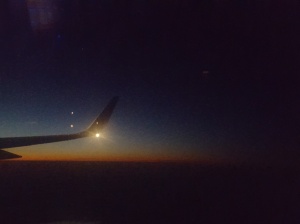
Dawn in the air
So I am stuck on a plane, eating rather tasteless penne and cheese while reading Rob MacFarlane’s “The Old Ways”. While Rob writes about walking in a way that resonates, he rarely eats. My memory of walking seems to be centered around food whether it be the Cadbury’s Fruit and Nut squares that Dad and I ate to keep us going, the corned beef and ketchup sandwiches that Dad loved, our discovery when visiting the Lake District for the first time of Kendal Mint Cake or the afternoon teas at the end, food was very much part of my venturing into the British countryside. In fact, I missed that most when I started hiking in the US as there was no pub lunch and no afternoon tea.
The second chapter in “The Old Ways” is an anthology of writers who have written about walking. So many books to read. I realized that I want to write about food the way Rob writes about wildness. I think food might be harder to do; food is civilized and urbane; cuisine has defined what we consider to be a meal, snack, beverage, fruit and vegetable. Culture has defined food down to when we should eat what; including the meals on planes. Why are we provided food on planes? What is the history behind air travel and food. After all food isn’t bought to you on a train or a bus. Stage coaches had to stop at inns so passengers could get food. On boats I guess food was provided or were steerage passengers expected to bring their own food with them?
What is the history of food on the move?
I read somewhere that our taste is affected by the pressure/altitude/air circulation on planes. Unfortunately these food providers aren’t aware of that fact. The overcooked broccoli was the only thing with any kind of flavor, even though its texture had been destroyed. The penne in white sauce was flavorless – the texture was redeemed by some minor crunchy bits where it had been overcooked. I have never liked cooked carrots, so I can’t judge what their flavor. No wonder my seatmate bought her own sandwiches.
I tried to search food for journeys on Google. The problem is that there are lots of journeys centered around food; mostly exploring the food of a new-to-you culture. I tried portable food and discovered that Lewis and Clark took portable soup with them on their journey. It wasn’t very popular apparently! GLEW by name, gluey in nature. The Smithsonian has a good summary of food in space. Of course we have popularity of Tang® and freeze-dried food thanks to NASA.
I checked through my library of food books. In “Pickled, Potted, and Canned” Sue Shephard has a chapter on “Great Journeys” that discusses some of the history of food on the move. Wealthy travelers on familiar routes were able to use monastery guest houses, hospices, and inns. Poorer people typically carried food with them, as did all people travelling less well known roads. A list of portable foods throughout the world includes a lot of dried or cured food, such as dried fruit, fish, meat, hardtack, jerky, pemmican and Johnny or journey cakes. Later in the chapter, Sue discusses polar explorers who weren’t so great at nutrition. I remember being told by one of my nutrition professors that Scott (of the Antarctic) partly failed because he didn’t believe that fruit was necessary to prevent scurvy. Sue agrees that Scott failed because of malnutrition and exhaustion.
As a food scientist, I am interested in the descriptions of what happens to food during travel. The shelf-life of dried meats and fruit dramatically decreased when ships reached the tropics. This is probably caused by a mixture of the high humidity and heat. At the other end of the climate spectrum, explorers in the Arctic and Antarctic found that the extreme cold changed their food. It must have been a shock to see that molasses had mostly solidified and that dried fruit was frozen tight in their wooden barrels. “Sugar formed a funny compound” is one description. Now I want to find out what that meant; what happens to sugar at –32 oC.
References
Dismukes K and Petty J I (2002)Food for Spaceflight, NASA, https://spaceflight.nasa.gov/shuttle/reference/factsheets/food.html
MacFarlane, R. (2012) The Old Ways. Penguin, London.
Rupp R (2014) The Luke-Warm, Gluey, History of Portable Soup. National Geographic, http://theplate.nationalgeographic.com/2014/09/25/the-luke-warm-gluey-history-of-portable-soup/
Shephard, S (2000) Pickled, Potted, and Canned. Simon and Schuster, New York. Chapter 13 “Great Journeys”.
Smithsonian Air and Space Museum (nd) Food in Space. https://airandspace.si.edu/exhibitions/apollo-to-the-moon/online/astronaut-life/food-in-space.cfm
Walker H (editor) (1996) Food on the Move: Proceedings of the Oxford Symposium on Food and Cookery, 1996. Prospect Books, Devon.
